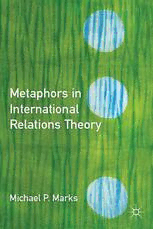Table Of ContentMetaphors in International
Relations Theory
AlsobyMichaelP.Marks
TheFormationofEuropeanPolicyinPost-FrancoSpain:TheRoleofIdeas,
InterestsandKnowledge
ThePrisonasMetaphor:Re-ImaginingInternationalRelations
Metaphors in International Relations
Theory
Michael P. Marks
METAPHORSININTERNATIONALRELATIONSTHEORY
Copyright©MichaelP.Marks,2011.
Softcoverreprintofthehardcover1stedition2011 978-0-230-11321-3
Allrightsreserved.
Firstpublishedin2011by
PALGRAVEMACMILLAN®
intheUnitedStates—adivisionofSt.Martin’sPressLLC,
175FifthAvenue,NewYork,NY10010.
WherethisbookisdistributedintheUK,Europeandtherestofthe
World,thisisbyPalgraveMacmillan,adivisionofMacmillan
PublishersLimited,registeredinEngland,companynumber785998,
ofHoundmills,Basingstoke,HampshireRG216XS.
PalgraveMacmillanistheglobalacademicimprintoftheabove
companiesandhascompaniesandrepresentativesthroughouttheworld.
Palgrave®andMacmillan®areregisteredtrademarksintheUnited
States,theUnitedKingdom,Europeandothercountries.
ISBN978-1-349-29493-0 ISBN978-0-230-33918-7(eBook)
DOI10.1057/9780230339187
LibraryofCongressCataloging-in-PublicationData
Marks,MichaelP.
Metaphorsininternationalrelationstheory/MichaelP.Marks.
p. cm.
1. Internationalrelations—Language. 2. Languageand
internationalrelations. I. Title.
JZ1253.5.M372011
327.101—dc22 2011002896
AcataloguerecordofthebookisavailablefromtheBritishLibrary.
DesignbyIntegraSoftwareServices
Firstedition:August2011
ForBrenda
Contents
Acknowledgments ix
1 Introduction 1
2 ThoughtsonMetaphor 9
3 TheMetaphoricalContextofInternationalRelations 29
4 ContributionsofMetaphorstoInternationalRelations
Theory 57
5 MetaphorsofPower 81
6 MetaphorsofInternationalSecurity 107
7 GameTheoryMetaphors 137
8 MetaphorsandChangingConceptionsofInternational
Relations 161
9 Conclusion 183
Notes 199
Bibliography 231
Index 257
Acknowledgments
Most of the inspiration for this book came from experiences in
the classroom teaching students at Willamette University. Given the
abstract nature of international relations in theory and practice, both
mystudentsandIhavefoundthatdifficultconceptscanbemadeintel-
ligiblethroughtheuseofmetaphoricalimagery.However,metaphors
can serve to both clarify and confound, and thus a critical analysis of
the metaphors that scholars use to frame the study of international
relations can yield insights beyond that which those metaphors were
originally intended to convey. Hence, my greatest intellectual debt
is not to established scholars of international relations, but to the
budding scholars who, in their role as undergraduates at Willamette,
engaged me in a philosophical investigation of metaphors. This book
wouldnotbepossibleifitwerenotfortheirintellectualcuriositythat
mademethinkdeeplyaboutthephenomenaexaminedinthisbook.
C h a p t e r 1
Introduction
T
hisisabookaboutdiscourse,specifically,scholarlydiscourseinthe
studyofinternationalrelations.Thepurposeofthebookistoanalyze
thelanguageofmetaphorininternationalrelations(IR)theory.Inhis
bookonthebalanceofpower(andthemetaphors,myths,andmodels
thereof),RichardLittle(2007,30)observesthat“thegeneralimpor-
tance of metaphors until very recently has simply not been taken on
board in International Relations.” While metaphors have been ever
present in the study of international relations (as the bibliography of
thisbookcanattest),littleexplicitorsustainedattentionhasbeenpaid
totheirrole.1 Withtheadventofthe“linguisticturn”ininternational
relationstheory,however,theneedtotacklethelanguageofmetaphor
isevident.
As will be discussed at greater length in Chapter 2, metaphors are
more than mere rhetorical devices. Recent scholarship in the field of
cognitive linguistics reveals that metaphors are essential to human
thought and communication. Metaphors evoke images of what is
known and provoke new understandings of topics under investiga-
tion. In academic inquiry the role of metaphors is multiform: they
can define a problem, delineate the scope of analysis, and suggest
hypotheses for testing theoretical propositions.2 One of the ironies
of international relations theory is that while the language of inter-
national relations can sound technical and arcane to the untrained
ear, the words IR scholars use to describe world affairs are highly
metaphorical. They speak and write of “anarchy,” “systems,” “struc-
tures,” “balances of power,” and “levels of analysis,” to name just a
few of the foundational metaphors of international relations theory,
not to mention the more specific metaphorical terms found in areas
2 Metaphors in International Relations Theory
such as international security, international political economy, strate-
gic interaction, and game theory. In short, throughout international
relationsliterature,whatisstudiedisexpressedinmetaphoricalterms.
ScopeoftheBook
This is not a book about how politicians and policymakers use
metaphors for the purposes of framing issues and formulating poli-
ciesinthe areaofinternationalaffairs.Thatisasubjectthathasbeen
addressedcapablybyotherscholars(see,e.g.,BeerandDeLandtsheer
2004).3 While not the central focus of this book, it is worth not-
ing that the lessons scholars derive from the way political leaders
use metaphors to frame foreign policy issues also are useful in dis-
secting the metaphors scholars themselves use in the course of their
investigations.4 Ironically, scholars of international relations are often
convinced that metaphors are safer in their hands than in the hands
ofpoliticians.Asthisbookwillshow,scholarswhostudyinternational
relations have found metaphors to be indispensable in the construc-
tion of explanatory theories. Although scholars have been adept at
investigating the discursive practices of foreign policy officials, they
have been less inclined to turn the lens on themselves to interrogate
themetaphorstheyusetoanalyzeinternationalaffairs.Inmanyifnot
most cases, the deployment of these metaphors borders on the cav-
alier. And, as this volume will demonstrate, metaphors that are used
haphazardly in fashioning international relations theories can lead to
analysesthatarelessthanfruitful.
Yet, perhaps because scholars can be casual in their use of
metaphors, they do not hesitate to criticize policymakers who delib-
erately use metaphors in formulating foreign policy. For example,
many of the chapters in the book Metaphorical World Politics (Beer
and De Landtsheer 2004) are quick to highlight what the authors
see as the pernicious use of metaphors by politicians in devising and
implementing government policy in the area of international affairs.
Richard Gregg (2004, 67–68), for instance, discusses how American
politicians invoked metaphors of disease (e.g., the “cancer” of com-
munism) during the Red Scare. Likewise, Robert Ivie (2004, 78–82)
referstometaphorsinvolvinga“civilizing”motivationthatAmerican
leadersutilizedwhentryingtoconvincepeopleoftheneedtospread
democracy around the world. In both these cases, the authors cast a
suspicious eye on political officials who use metaphors for the pur-
pose of buttressing morally suspect foreign policies. Yet, a similar
scrutiny is rarely applied to scholars of international relations who

